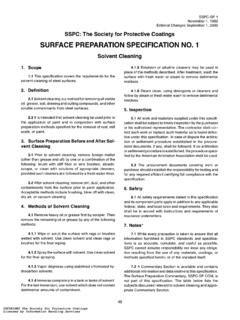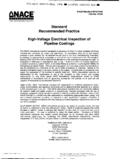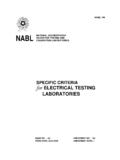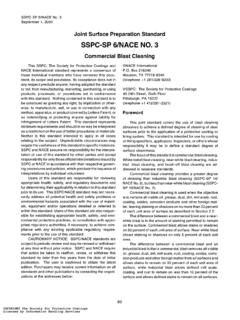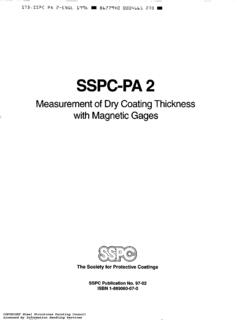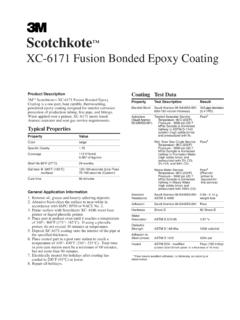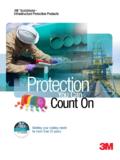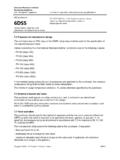Transcription of Matilde de Romero - Invoice INV-170140-EEKBU3, …
1 Standard Practice Control of Internal Corrosion in Steel Pipelines and Piping Systems This NACE International (NACE) standard represents a consensus of those individual members who have reviewed this document, its scope, and provisions. Its acceptance does not in any respect preclude anyone, whether he or she has adopted the standard or not, from manufacturing, marketing, purchasing, or using products, processes, or procedures not in conformance with this standard. Nothing contained in this NACE standard is to be construed as granting any right, by implication or otherwise, to manufacture, sell, or use in connection with any method, apparatus, or product covered by Letters Patent, or as indemnifying or protecting anyone against liability for infringement of Letters Patent.
2 This standard represents minimum requirements and should in no way be interpreted as a restriction on the use of better procedures or materials. Neither is this standard intended to apply in all cases relating to the subject. Unpredictable circumstances may negate the usefulness of this standard in specific instances. NACE assumes no responsibility for the interpretation or use of this standard by other parties and accepts responsibility for only those official NACE interpretations issued by NACE in accordance with its governing procedures and policies which preclude the issuance of interpretations by individual volunteers.
3 Users of this NACE standard are responsible for reviewing appropriate health, safety, environmental, and regulatory documents, and for determining their applicability in relation to this standard prior to its use. This NACE standard may not necessarily address all potential health and safety problems or environmental hazards associated with the use of materials, equipment, and/or operations detailed or referred to within this standard. Users of this NACE International standard are also responsible for establishing appropriate health, safety, and environmental protection practices, in consultation with appropriate regulatory authorities if necessary, to achieve compliance with any existing applicable regulatory requirements prior to the use of this standard.
4 CAUTIONARY NOTICE: NACE standards are subject to periodic review, and may be revised or withdrawn at any time in accordance with NACE technical committee procedures. NACE International requires that action be taken to reaffirm, revise, or withdraw this standard no later than five years from the date of initial publication. The user is cautioned to obtain the latest edition. Purchasers of NACE International standards may receive current information on all standards and other NACE International publications by contacting the NACE International FirstService Department, 1440 South Creek Drive, Houston, Texas 77084-4906 (telephone +1 [281] 228-6200).
5 Approved 2006-12-01 NACE International 1440 South Creek Drive Houston, TX 77084-4906 +1 281/228-6200 ISBN 1-57590-208-7 2006, NACE International NACE SP0106-2006 Item No. 21111 Matilde de Romero - Invoice INV-170140-EEKBU3, downloaded on 10/30/2008 12:37:04 PM - Single-user license only, copying and networking NACE International i _____ Foreword The purpose of this NACE standard practice is to describe procedures and practices for achieving effective control of internal corrosion in steel pipe and piping systems in crude oil, refined products, and gas service. Because of the complex nature and interaction between constituents that are found in gas and liquid ( , oxygen, carbon dioxide, hydrogen sulfide, chloride, bacteria, etc.)
6 , certain combinations of these impurities being transported in the pipeline may affect whether a corrosive condition exists. Identification of corrosive gas and liquid in a pipeline can only be achieved by analysis of operating conditions, impurity content, physical monitoring, or other considerations. Therefore, gas, liquids, and operating conditions must be monitored and evaluated on an individual basis in order to accurately assess the effects of their presence or absence in the pipeline . This standard presents general practices and preferences in regard to control of internal corrosion in steel piping systems.
7 This standard is intended for use by pipeline operators, pipeline service providers, government agencies, and any other persons or companies involved in planning, designing, or managing pipeline integrity. This standard was prepared by Task Group (TG) 038 on Control of Internal Corrosion in Steel Pipelines and Piping Systems. TG 038 is administered by Specific Technology Group (STG) 35 on pipeline , Tanks, and Well Casings. This standard is issued by NACE International under the auspices of STG 35. In NACE standards, the terms shall, must, should, and may are used in accordance with the definitions of these terms in the NACE Publications Style Manual, 4th ed.
8 , Paragraph Shall and must are used to state mandatory requirements. The term should is used to state something good and is recommended but is not mandatory. The term may is used to state something considered optional. _____ Matilde de Romero - Invoice INV-170140-EEKBU3, downloaded on 10/30/2008 12:37:04 PM - Single-user license only, copying and networking ii NACE International _____ NACE International Standard Practice Control of Internal Corrosion in Steel Pipelines and Piping Systems Contents 1.
9 1 2. 1 3. Structure Design ..2 4. Corrosion Detection and Measurement .. 4 5. Methods for Controlling Corrosion .. 5 6. Evaluating the Effectiveness of Corrosion Control Methods .. 7 7. Operation and Maintenance of Internal Corrosion Control 7 8. Corrosion Control 9 9 Appendix A: Typical Gas Quality Specification (Nonmandatory) .. 11 Appendix B: Publications Providing Information Necessary for Determining the Quantity of Impurities (Nonmandatory).. 12 Appendix C: Impacts of Common Impurities (Nonmandatory) .. 13 _____Matilde de Romero - Invoice INV-170140-EEKBU3, downloaded on 10/30/2008 12:37:04 PM - Single-user license only, copying and networking NACE International 1 _____ Section 1: General This standard presents recommended practices for the control of internal corrosion in steel pipelines and piping systems used to gather, transport, or distribute crude oil, petroleum products, or gas.
10 This standard serves as a guide for establishing minimum requirements for control of internal corrosion in the following systems: (a) Crude oil gathering and flow lines (b) Crude oil transmission (c) Hydrocarbon products (d) Gas gathering and flow lines (e) Gas transmission (f) Gas distribution (g) Storage systems This standard does not designate practices for every specific situation because the complexity of pipeline inputs and configurations precludes standardizing all internal corrosion control practices. The provisions of this standard should be applied under the direction of competent persons who, by reason of knowledge of the physical sciences and the principles of engineering and mathematics acquired by education or related practical experience, are qualified to engage in the practice of corrosion control and risk assessment on carbon steel piping systems.
